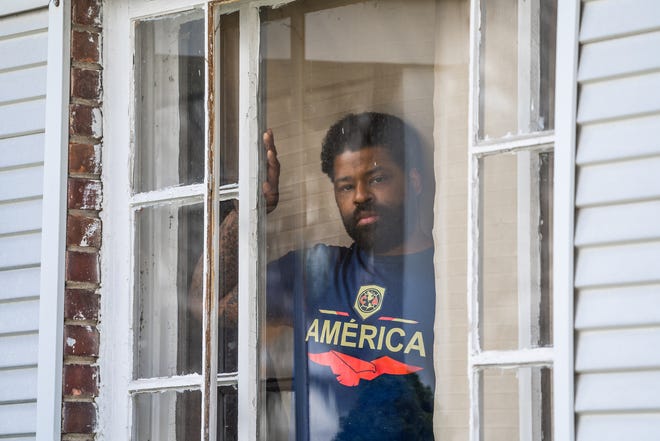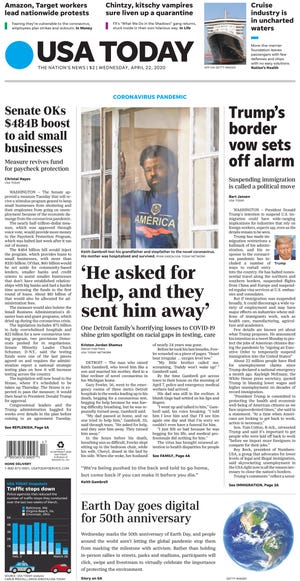
Photograph Source: mathiaswasik – CC BY 2.0
Trumptrocities
Writing the third chapter of my latest book This Happened Here: Amerikaners, Neoliberals, and the Trumping of America, was an exhausting and soul-chilling experience. Titled “A Fascist in the White House, 2017-21,” this chapter attempted to catalogue, categorize, and cross-reference the transgressions of the malignant ogre Donald Trump as US president. It records more than 400 “Trumptrocities” filed and cross-listed across 8 different folders. Among the orange-brushed brute’s many offences: the caging and theft of migrant children; pardoning the sadistic war criminal Eddie Gallagher; the placement of open Camp of the Saints fascists like Steve Bannon and Stephen Miller in top advisory roles; embrace of the slaveowners’ Confederacy; defense of murderous white supremacists in Charlottesville; a mass-murderous and pandemicist response to Covid-19; the ugly nativist and sexist call for Ilhan Omar and the Squad to “go back to your crime-ridden countries;” the juvenile disfiguring of a weather map; the sick racist worsening of Puerto Rico’s horrific Hurricane Maria experience; the insane claims that the corporate Democrats are “Marxists” and “radical Left” and that “the radical Left” was taking over America; mad declarations of his own special genius; repeated tyrannical assaults on independent media; open encouragement and cultivation of political violence; embrace of fascist militiamen who attacked state capitals to protest basic public health protections; constant denigration of women; embrace of authoritarian rulers the world over; jokes about being “president for life;” calls for the military suppression of the George Floyd Rebellion; the holding of a bizarre Christian nationalist photo-op following a brutal attack on civil rights protesters in Lafayette Square; the ordering of a police state execution of an antifascist; the arch-criminal assassination of a top Iranian general in Iraq; the embrace of neo-Nazi Q’Anon and fascist lunatics like Marjorie Taylor Greene; providing over for the Saudis’ literal butchering of journalist Jamal Khashoggi; cuddling up to world fascist hero and future Bucha butcher Vladimir Putin; the embrace of a white teen MAGAt who slaughtered two people with an AR-15 at a Black Lives Matter rally in Kenosha, Wisconsin; handing the nation’s climate and energy policy portfolio to fossil fuel interests determined to turn the planet into a giant Greenhouse Gas Chamber; and, by the way, the attempted subversion and overthrow of the 2020 presidential election.
That’s just the short list. The full record is mind-boggling even if it was unsurprising to those who knew that The New Yorker’s Adam Gopnik was on to something when he issued this warning in early May of 2016:
‘There is a simple formula for descriptions of Donald Trump: add together a qualification, a hyphen, and the word “fascist” …his personality and his program belong exclusively to the same dark strain of modern politics: an incoherent program of national revenge led by a strongman; a contempt for parliamentary government and procedures; an insistence that the existing, democratically elected government…is in league with evil outsiders and has been secretly trying to undermine the nation; a hysterical militarism designed to no particular end other than the sheer spectacle of strength; an equally hysterical sense of beleaguerment and victimization; and a supposed suspicion of big capitalism entirely reconciled to the worship of wealth and ‘success.’… The idea that it can be bounded in by honest conservatives in a Cabinet or restrained by normal constitutional limits is, to put it mildly, unsupported by history.’
That was dead on, even if Gopnik left out the critical race and gender components of the fascist formula – and even though the “normal constitutional limits” did just barely hold in 2020-21 (if Republican voter suppression and election rigging efforts work how they are supposed and the reigning media and politics culture stuck in its longstanding “normalcy bias,” the limits may well fail in 2024-25).
Attempted Reichstags
That Trump would test those limits to the point of an attempted coup was also predictable early on. It was clear almost from the start of his presidency that Trump had no interest in trying to stay in power the normal bourgeois electoral way: by making and trying to sell policies meant to appeal to enough voters and keeping enough ruling class players happy to prevail in the next election. As Yale historian Timothy Snyder predicted just three months into the Trump reign, the nation’s 45th president would seek to stay in office through some sort of Reichstag Fire[1] moment(s) that would permit him to consolidate power over and against the will of the populace and electorate.
In the long hot summer of 2020, consistent with Snyder’s warning, Trump was in putsch mode, looking for Reichstag Fires. He openly flouted public opinion on the pandemic, public health, civil rights, race, police statism, and the rule of law. This kept his approval rate in the low 40s and the militantly uncharismatic, basement-dwelling corporatist Joe Biden well ahead of him in national polls. This was nothing for his critics and opponents to celebrate however, for, when combined with his clear desire to stay in power, it suggested strongly that he was going to try to keep the presidency in undemocratic, anti-constitutional, and violent ways.
Trump’s first attempted 2020 Reichstag was the beautiful George Floyd uprising, which he called “radical Left” and wanted to crush in the streets with the 101st Airborne, much to the dismay of even his own military command. His next Reichstag try was the 2020 election itself, which he falsely claimed was “stolen” by the “radical Left” Democrats. This Big Hitlerian Lie was the insane claim and running through the addled minds of the thousands of maniacs who stormed the US Capitol at the call of their deranged Dear Leader on the sixth day of 2021. The terrible events of January 6th were final proof that there had indeed been a fascist[2] in the White House since January 20, 2017. As US House investigators are learning in ever greater detail, Trump and his team were deeply involved in the Attack on the Capitol, the last and desperate phase of the Trump team’s attempt to carry out a coup d’état and stay in power over and against the judgement of voters and even of an idiotic 18th Century Electoral College already tilted to the right.
Like Another Fascist After Another Failed Putsch
It was all very consistent with warnings made early on by astute political observers like Gopnik and Henry Giroux and with the likely serial rapist Trump’s long Mafia-like business career and sociopathic personality going back well before his emergence as a serious presidential contender. The malignant hyper-narcissist and “instinctive fascist” Donald Trump has long been one of the sickest individuals ever spawned by the human species.
How is this auburn-tinted swine not caged? Why does this malignant bag of fascist poison still stain the nation and world with its continuing presence as the de facto leader of one of the two ruling political parties in the world’s most powerful state? How does this deranged, blood-soaked pathogen from Queens still walk free? How does the tiny-fingered tangerine-tinted tyrant roam the land with Secret Service protection to spread yet more Hitlerian falsehood, including the violently absurd and destructive claim to have won the 2020 election – an attempted Reichstag Fire the noxious putschist Trump is still trying to fan?
The evidence of Trump’s technical/statutory criminality as president is abundant on at least six counts:
* Interfering with the certification of Biden’s election win on 1/6/2021.
* Trying to bully the Georgia Secretary of State into falsifying the popular presidential vote in Georgia.
* Inciting physical attacks on US Congresspersons and Congressional staff on 1/6/2021.
* Interfering with the federal investigation of the Capitol Riot.
* Removing government documents and tampering with and destroying classified White House documents.
* Using the threat to withhold military assistance to blackmail Ukraine president Volodymyr Zelensky into digging up political dirt on Biden in 2019.
(To be sure, these aren’t even Trump’s worst crimes. His most horrendous offences as president were Covid-19 pandemicide and his quieter but even deadlier crime of pedal-to-the-medal ecocide.)
From the US House Select Committee to Investigate the January 6th Attack on the United States Capitol (hereafter “House Select Committee”) and US Attorney General Merrick Garland down to the district attorney office of Fulton County, Georgia, the Michigan Attorney General, the New York Attorney General, and the Manhattan DA’s office, top Democratic policymakers and legal authorities and key state and local prosecutors have more than enough ammunition to prosecute and incarcerate the Malignant One. But so what? All indications are that the dismal Dems will let Trump and his fascist collaborators skip down a path like the one enjoyed by Adolf Hitler following the failed Nazi Party Beer Hall Putsch: no real punishment and continued liberty to spread hate, lies, and fascism.
Properly surnamed after an inert decorative object, Garland shows little inclination to pull the legal trigger on Herr Trump. Biden pretends to be bothered by this but shows no interest in using his bully pulpit to push his listless, Lieberman-and Obama-like AG from passivity to prosecution. The demobilizing dollar Democrats seem ready to let the clock run out on the House’s January 6th committee as the Amerikaner Party of Trump (the APoT, formerly known the Republicans) prepares to take back the House and squelch the investigation this fall.
It isn’t just Trump who is getting away with an attempted fascist coup. The charges made against, and the sentences handed down to his frothing minions who waylaid the US Capitol have been pathetically mild. Garland won’t prosecute coup complicit Republifascist Congresspersons and former White House staffers who have essentially told the Jan. 6 committee to go f*ck itself by flatly refusing to comply with Congressional subpoenas.
The Rod Stewart-esque message to Trump and his late-fascist freakshow is clear:
Old thugs be free tonight.
Time is on your side,
Don’t let them put you down, don’t let ’em push you around,
don’t let ’em ever change your point of view.
A Gentleman’s Agreement
What gives? I won’t pretend to be able to look into the corrupted minds of the depressing neoliberal elitists atop the Democratic Party, but my semi-educated guess is that they have no serious desire to cage the lethal orange creature from Hell for four basic reasons. The first explanation is their normative commitment to the belief that imperial US presidents do in fact operate above the law and can’t properly perform their often-dirty duties if they think they might be criminally liable for nefarious actions even after leaving office. In the name of “look[ing] forward as opposed to backwards” (to quote future war criminal Barack Obama as President-Elect in January of 2009), this is a longstanding “gentleman’s agreement” between the two US ruling class parties. It apparently holds even if a former president tried to stay in power by overthrowing a bourgeois-democratic election in the imperial “homeland” itself!
Fear of Retaliation After Congress Reverts to Republifascist Control
A second and related explanation relates to the Dems’ fear of political-legal retaliation after they lose the US House (and perhaps the Senate) this Fall and the presidency in 2024-25, thanks in no small part to their ongoing captivity to capital, which continues to expose the elitist inauthenticity of their thoroughly disingenuous claim to be “the party of the people.” The “lock her up” APoT may well undertake multiple trumped-up party-line revenge impeachments of Biden no matter what, but the Justice Department going hard after the fascist criminal Trump will guarantee that ugly likelihood impeachments and add on wild prosecutions of Biden and Harris by a US attorney general taking orders from a Fuhrer Trump or DeSantis in 2025 or 2026. Congressional Democrats and liberal media personnel would also face significantly escalated legal, political, and physical menace. These are prices and risks top Democrats are unwilling willing to pay and take.
Fear of Violence
A third explanation is fear of neofascist violence. It’s not for nothing that Fulton County, Georgia’s Black female district attorney Fani Willis had to request FBI security assistance after she had the audacity to launch an investigation of crime boss Trump’s Gotti-like attempt to intimidate the Georgia Secretary of State into “finding” enough Trump votes to reverse the 2020 outcome in that battleground state. A considerable section of the very preponderantly white male Trumpenvolk is armed and dangerous, ready to maim and kill in defense of their demented hero. A serious prosecution and conviction of their cult object would certainly spark bloody revenge from the more deranged and weaponized of the orange-brushed beast’s little green men.
Pied Piper II?
A fourth Dem consideration is electoral. Remember the “Pied Piper” strategy of 2015-16, revealed by WikiLeaks – the Clinton Dems’ determination that Trump’s emergence as the top 2016 Republican presidential candidate would guarantee a Hillary victory and should therefore be encouraged? After eight years of standard cringing service to Wall Street, corporate America, and the miliary industrial complex under Obama (as under Bill Clinton 2003-2001), the capitalist-imperialist “inauthentic opposition” party (IOP) was looking forward to running against someone so awful that the counterfeit nature of their claim to be a progressive party wouldn’t matter. They wanted to run against Trump.
We saw how that worked out and yet we should not discount the possibility that the Dems want to face Trump yet again, using the horrific nature of his twice-impeached presidency and his real and alleged connections to Russia and Putin to (they think) crush him in the 2024 election. The Russia and Putin links likely hold special meaning for the Dems in the wake of Putin’s criminal invasion of Ukraine. The Dems’ will saddle “Putin toy” Trump with the crimes of Mariupol, Bucha, and, perhaps, Putin’s coming US-/NATO-egged-on deployment of tactical nuclear weapons in Ukraine.
If the IOP (the Dems) do in fact want to run against Trump for a third time, the idea would probably be to keep him out of jail and not to feed the paranoid victimization fantasies of his Amerikaner base by actually prosecuting him for, you know, trying to overthrow the US constitutional bourgeois republic.
Why the Ruling Class Lets the Trumpenstein Live On
The nation’s ruling class could turn off the Trump show once and for all. Why doesn’t it pull the plug, one way or another, on Malignant Orange? It’s riven by its own internal divisions, with not insignificant parts of the bourgeoisie aligned with revanchist white nationalism and fossil fascism. Much of the majority of the US wealth and power elite that doesn’t like Trump and Trumpism-fascism probably doesn’t mind his continuing presence as a “bad cop” bogeyman driving voters to cower under the umbrella of the nicer cop corporate and imperial Democrats. And the nation’s masters are happy for the rabble (the citizenry) to be screaming and even shooting at each other across the binary red-blue partisan, geographic (largely rural v. metro), and culture war divides instead of uniting against their parasitic capitalist owners and the broader bourgeois and imperial system. America’s owners expect to keep rolling in profits no matter whether the government is held down by neofascists or neoliberals or some combination of the two.
“Normalcy Bias”
All of which helps explain why our rulers’ so-called mainstream media seems now, in Salon writer Chauncy de Vega’s words, to have “made its peace with fascism.” As de Vega explains:
‘America’s democracy crisis is getting worse. The Republican-fascists and their allies are undeterred. If anything, they are energized and have escalated their attempts to end democracy in America…In the new America the Republican-fascists are trying to force into being, if you are not one of the MAGA elect, your life will be hell. If you think your life is difficult now, it will be orders of magnitude worse if the fascists and their movement achieve their goals… But instead of explaining this reality to the American people in a consistent, clear, repeated, transparent and direct way – while providing the larger context and importance of these facts – the mainstream news media has, for the most part, chosen to focus on the latest distraction…As public opinion polls have repeatedly shown, the result is a growing lack of concern about Trump’s coup attempt, the Republican-fascist movement and the overall crisis of democracy… The mainstream media is possessed by normalcy bias and clings to fantasies of an old order of more or less functional democracy. What we describe as “normal politics” colors how the news media, and the country’s leadership class more generally, views all political events…There is…the…prospect that the news media as an institution, and many of its most prominent voices, will simply adapt to whatever new “normal” a full-on Republican-fascist regime imposes once it takes power in 2024 or in the years beyond. If one worships at the mantle of power and influence, rather than truth and democracy, such a decision is only natural’ (emphasis added).
Poor Jamie Raskin: Bless His Heart
In the meantime, let us offer some praise and pity for poor Jamie Raskin, a US House manager of Trump’s second impeachment (the one over January 6th): praise for having decency, intelligence, and courage to say the F-word (fascism) when describing the right-wing Republican forces that menaces the US; pity for his childish faith in “normal” constitutional mechanisms to defeat the threat. The former law professor Raskin is so passionately enthralled by his country’s deeply conservative aristo-republican 18th Century Constitution that he claimed (in an MSDNC documentary titled “Love the Constitution”) to seriously believe that the House case for the conviction of Trump after January 6th would be so convincing as to garner a 100-0 vote in the US Senate. This was an utterly ludicrous thing to have expected (or claim to have expected) from a Senate half occupied by the fossil fascist APoT – a Senate containing seven “Republicans” who had refused to certify Biden’s clear victory even right after the assault on the Capitol. Now, bless his heart, Raskin wants us to know that the long, drawn-out House Select Committee’s June 2022 hearings will “blow the roof off the House.” Here’s some of what Raskin said to an event hosted by Georgetown University last week:
“The hearings will tell a story that will really blow the roof off the House…No president has ever come close to doing what happened here in terms of trying to organize an inside coup to overthrow an election and bypass the constitutional order…and then also use a violent insurrection made up of domestic violent extremist groups, white nationalist and racist, fascist groups in order to support the coup…It’s anybody’s guess what could have happened — martial law, civil war. You know, the beginning of authoritarianism…I want people to pay attention to what’s going on here, because that’s as close to fascism as I ever want my country to come to again.”
Okay, the privileged minority of people who have time, energy, and inclination to “pay attention to what’s going on” (I tenuously include myself in that category) look forward to the hearings and findings. But so what if the US House gets its “roof blown off?” What then? Will the media shift from covering the latest horror in Eastern Europe to alert USAers to the crisis of democracy and the steady of advance of fascism at home? (The main domestic political story to challenge World War III for headline coverage in June should be the Republifascist Supreme Court’s reversal of Roe v. Wade and [one would hope] the mass protests that decision could well engender.)
What’s the House going to do with its roof blown off? Convince a half-Republifascist Senate to convict Trump 18 months after the failed putsch in a time when 57% of Republicans think the Capitol Riot was “an act of patriotism”? The savagely gerrymandered lower chamber of Congress is by all indications slated to return to Republifascist, white-nationalist control later this year, and that’s the end of the House Select Committee. The Senate may well also revert to management by the arch-sexist white nationalist party.
The Constitution superfan Raskin says the committee aims to have a report out about their investigation by the end of the summer or early fall. Super. Order your advance copy now: it will no doubt be an indispensable primary source for future historians, assuming we still have historians in coming years. In the meantime, it will look great gathering dust on a shelf next to The Mueller Report.
And what’s with “that’s as close to fascism as I ever want my country to come to again”? Is Raskin paying attention to what’s happening right now across the US and how it all points to a likely Republifascist return to triple-branch governmental power under a President Trump II or DeSantis I in 2025? Amerikaner fascism is marching along quite well underneath the fog of Ukraine, with book and abortion banning in the red state lead. As de Vega noted two days ago, “America’s democracy crisis shows no signs of ending anytime soon. Too many Americans are still in denial about the existential threat that Donald Trump, his movement and the broader white right pose to the future of the United States.” Maybe Raskin would like to put his constitutional and procedural fantasies aside long enough to come out in the streets wearing a green bandana to join Rise Up 4 Abortion Rights (RU4AR) in sending a message to the absurdly far-right Supreme Court: if you insist on subverting the rule of law by overturning Roe v. Wade (a decision still supported by 72% of the US populace), then we intend to shut this country down in holy opposition to the female enslavement of forced motherhood.
Endnotes
+1. The Holocaust Encyclopedia: “On February 27, 1933, the German parliament (Reichstag) building burned down. The Nazi leadership and its coalition partners used the fire to claim that Communists were planning a violent uprising. They claimed that emergency legislation was needed to prevent this. The resulting act, commonly known as the Reichstag Fire Decree, abolished a number of constitutional protections and paved the way for Nazi dictatorship.”
+2. It was at this absurdly late date that the leading historian of European fascism Robert Paxton, author of the widely read volume The Anatomy of Fascism, finally stood down from his denial of Trump’s fascism. See Robert Paxton, “I’ve Hesitated to Call Donald Trump a Fascist. Until Now,” Newsweek, January 11, 2021. The third chapter, titled “The Anatomy of Fascism Denial,” of my new book This Happened Here is a rigorous and sometimes amusing survey and critique of the often preposterous lengths many mostly older, white, and male academics (20th Century European historians especially), pundits, and “left”-identified commentators went to deny, misunderstand, and underestimate the fascist essence of Trump and Trumpism.












